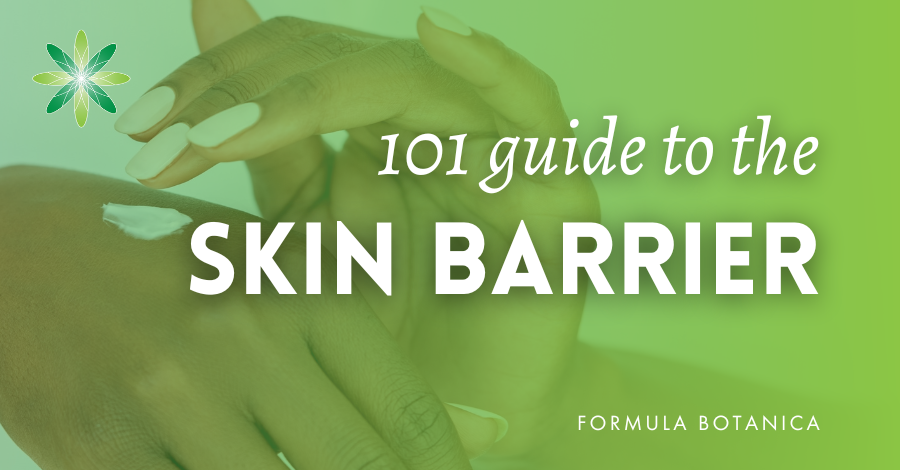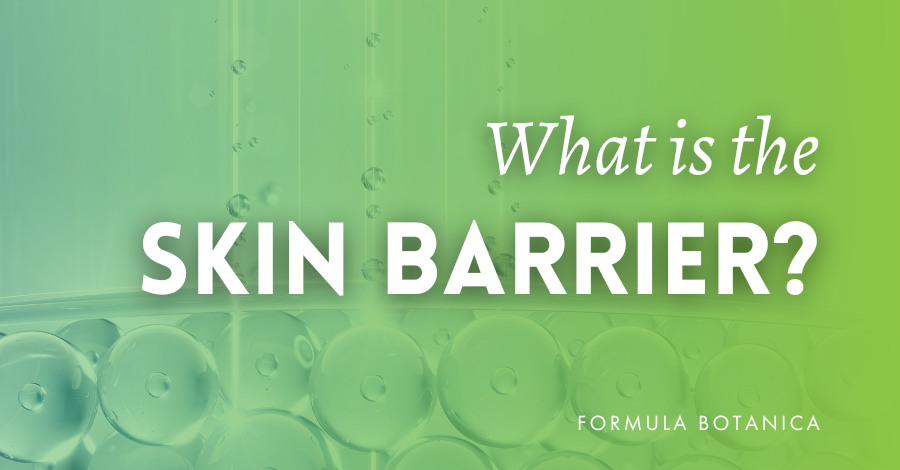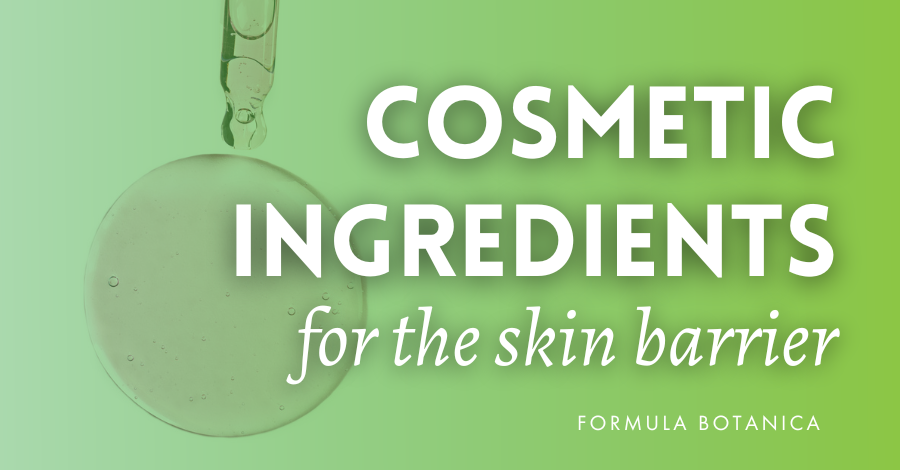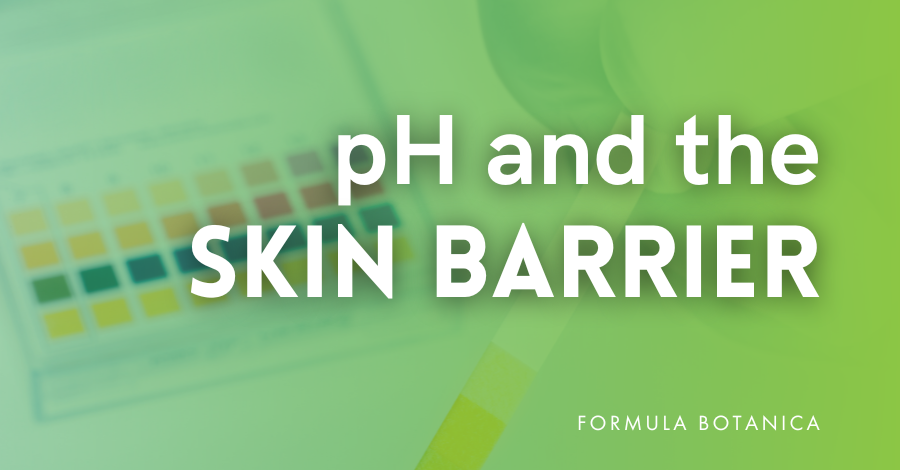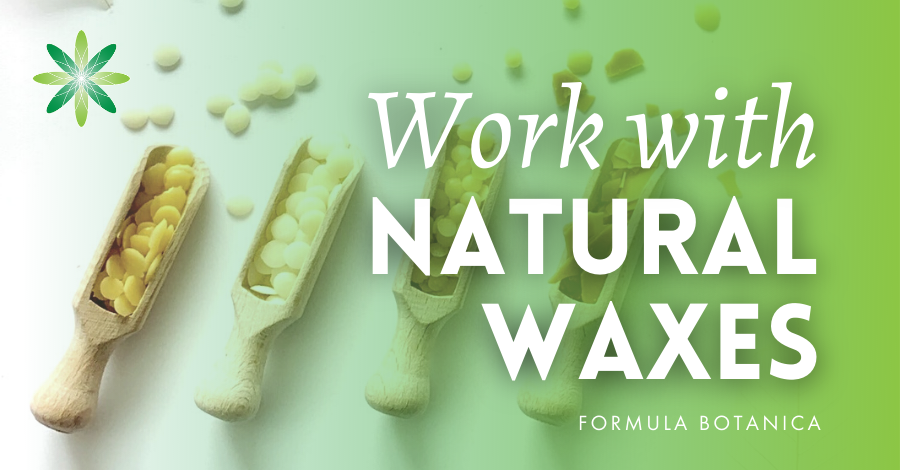The skin barrier is a hot topic in the world of cosmetics these days. With increasing awareness about the importance of skin health and the Covid-19 pandemic drawing attention to skin hygiene, skin damage from mask wearing, and wellness in general, many people are curious about what the skin barrier is and why it’s essential for maintaining healthy skin.
The skin barrier serves as the first line of defence for the skin and is essential for maintaining overall skin health. A healthy skin barrier helps to prevent moisture loss, protect against environmental aggressors, and maintain a healthy skin microbiome. A compromised skin barrier, on the other hand, can lead to dryness, irritation, inflammation, and even skin conditions such as eczema and acne.
As natural cosmetic formulators looking to create effective skincare products to encourage and support healthy-looking skin, understanding the skin barrier is a crucial first step in designing effective formulations for the face, body and scalp.
In this blog post, we provide an essential guide to the skin barrier, covering its physiology, its role in maintaining healthy skin, as well as ingredients that are key to protecting, restoring and nourishing the skin barrier.
Why is everyone talking about the skin barrier these days?
Recent research (i, ii) has shown that the skin barrier is not just a physical barrier but is also involved in various immune and inflammatory responses. A compromised skin barrier can lead to chronic inflammation, which is linked to various skin conditions and premature skin ageing. This new understanding of the skin barrier’s function has led to an increased focus on developing skincare products that support the skin barrier’s health and function.
Today, beauty consumers are keenly researching their own skincare issues and seeking out specific ingredients that assist in repairing a compromised skin barrier showing signs of, for example, rosacea, dryness, and premature ageing. In response, the beauty media is often seen recommending skincare products that contain ingredients such as ceramides, hyaluronic acid, niacinamide, and fatty acids, which are known to help strengthen the skin barrier, improve hydration levels, and promote overall skin health. We talk in more detail later about natural sources of these.
First, let’s recap the physiology of the skin itself, as its various layers each play a specific role in maintaining the skin’s barrier function.
What is the Skin Barrier?
The skin protects our body from damage caused by mechanical, chemical, or microbiological action, and UV radiation. If the skin barrier is damaged, besides losing water, it becomes more susceptible to irritating compounds and infections. The skin barrier is very effective in keeping foreign substances out, and most compounds do not easily penetrate the skin.
The skin is composed of the epidermis, dermis, and subcutaneous tissue. In brief, the epidermis comprises several layers, of which the outermost layer – the stratum corneum – is responsible for creating and maintaining the skin barrier.
The stratum corneum: this is composed of flattened dead skin cells (corneocytes) that are surrounded by a lipid-rich matrix. You can imagine this as a “brick-and-mortar” structure. This structure protects against environmental aggressors, such as UV radiation, pollution and microorganisms, and prevents water loss (proper hydration is essential for the good functioning of skin cells and components) and the entry of foreign substances.
The dermis: this contains collagen, elastin and other structural components that provide support and elasticity to the skin. The subcutaneous tissue (hypodermis) is a thick layer found below the dermis. Although it is still referred to as a skin layer, it is not technically considered part of the skin. It is sandwiched between the dermis and the fascia (a connective tissue surrounding muscles). This layer contains coarse collagen bundles and mainly comprises adipocytes (fat cells) that help regulate body temperature and provide cushioning for the skin.
The layers underneath the stratum corneum within the epidermis and dermis contain other important components, such as melanocytes, which produce skin pigment, and fibroblasts, which produce collagen and elastin to keep the skin firm and elastic.
How is it compromised?
Environmental factors such as pollution, UV rays, and harsh weather conditions can strip the skin of its natural lipids, damaging the skin barrier. Additionally, lifestyle factors such as smoking, excessive alcohol consumption and a poor diet can also compromise the skin barrier. All of these factors mentioned have one thing in common – they cause oxidative stress.
When the skin barrier is compromised, we may see various skin issues, including increased sensitivity, dryness, and inflammation, signs of premature ageing, and also acne breakouts as bacteria can penetrate the skin more easily. Common skin conditions that can result from a compromised skin barrier include eczema, psoriasis, rosacea, and atopic dermatitis. These conditions can cause intense itching, redness, and discomfort, making it challenging to maintain healthy skin.
Cosmetic ingredients to help maintain a healthy skin barrier
First, it is important to stress that cosmetics act topically and do not cure skin issues such as those we mentioned above. However, certain cosmetic ingredients can assist the skin barrier’s function and support its natural role.
When it comes to formulating natural cosmetics that help protect, nourish and support the skin barrier, it is important to understand the three key categories of ingredients of particular relevance.
Humectants:
These are ingredients that attract and hold onto water, helping to hydrate and plump up the skin. They can do this by attracting water from a humid environment as well as by drawing water from the skin’s deeper layers. Examples of natural humectants include glycerine, hyaluronic acid, honey and aloe vera gel.
When formulating, it’s important to balance the amount of humectants used. Too high a percentage can create a sticky skin feel. For more on how humectants work in our skincare, see:
Emollients:
These ingredients help soften the skin by applying a lipid layer that fills the gaps between desquamating corneocytes (epidermal dead skin cells), creating a smoother surface. Many natural plant oils and extracts can be particularly beneficial for the skin barrier. For example, oils such as argan, jojoba and rosehip are rich in antioxidants and fatty acids that help to protect the skin barrier from environmental stressors, while chamomile extract (macerated in oils like sunflower) can have anti-inflammatory properties that can help to soothe the skin. Other beneficial natural ingredients for the skin barrier include calendula extract and sea buckthorn oil.
For inspiration on emollient plant oils, see:
The top 10 botanical oils every formulator needs
Why you need seed oils in your skincare and haircare
Occlusives:
These create a barrier on the skin that helps to lock in moisture, prevent water loss and protect the skin from external irritants. Examples of occlusive ingredients include beeswax, shea butter, and cocoa butter. Again, it is important to experiment to obtain the right balance of occlusives with other ingredients to ensure the optimal skin feel and effectiveness of your product. However, if you are formulating heavy-duty barrier creams for hands or as nappy balms, then you might need a higher amount of occlusives in your formulation. For inspiration about natural butters that act as occlusives and emollients, read our post:
If you’d like to read more about how all these functional ingredients complement each other in helping maintain our skin barrier, see our article:
High-performance ingredients to include
In addition to our three core categories of ingredients, we can explore some interesting high-performance ingredients to target specific skin barrier issues. These include the following:
Ceramides
Skin barrier function is defined by the lipids found in the stratum corneum extracellular space, or matrix, between the corneocytes that we mentioned above. Ceramides comprise about 30–40 % of the stratum corneum’s total lipids by mass (some sources state it is 50%), but there are also fatty acids and cholesterol. Together, all three types of lipids maintain a functioning skin barrier. Moisturisers containing ceramides help to restore and reinforce the skin barrier, preventing water loss and maintaining the skin’s hydration levels. Natural sources for ceramide extracts include rice, wheat and oats. For a guide to natural ceramides, see our formulation:
Hyaluronic acid
The humectant hyaluronic acid is a naturally occurring molecule found in the skin as well as other parts of the body. It is a type of glycosaminoglycan, which is a long chain of sugar molecules that can hold onto large amounts of water. For cosmetics, hyaluronic acid is typically produced by bacterial fermentation or through biotechnology and is used as an active ingredient to help hydrate and moisturise the skin.
The molecular weight of hyaluronic acid is an important factor to consider when formulating. High-molecular-weight hyaluronic acid forms a protective film on the skin’s surface, which helps to prevent moisture loss and protect the skin from environmental stressors. On the other hand, low-molecular-weight hyaluronic acid can penetrate deeper into the skin, where it can provide additional hydration and stimulate collagen production. For more detail on hyaluronic acid and its cosmetic forms, see our post:
Niacinamide
Niacinamide is a biologically available form of vitamin B3 that has been shown to be highly efficient in improving the skin barrier’s function. It has numerous cosmetic benefits, but of particular interest to our discussion on the skin barrier is its ability to inhibit oxidative processes in the skin, such as protein oxidation, as well as reduce TEWL and generally improve the lipid barrier function. Serums containing niacinamide can help to reduce inflammation, improve hydration levels, and strengthen the skin barrier. For more details on niacinamide, see our formulation:
How pH affects skin barrier function
Maintaining a healthy pH balance in your formulations is also crucial for protecting and supporting the skin barrier. The skin’s natural pH is slightly acidic, with a range of around 4.5 to 6. This acidity helps to protect the skin from harmful bacteria, viruses, and other environmental stressors.
When the pH of skincare products is too high or too low, it can disrupt the skin’s natural pH balance, leading to dryness, irritation, and even infection. For example, using alkaline soaps or cleansers can strip the skin of its natural oils and disrupt its pH, while using acidic products, such as chemical peels or exfoliants, can lead to over-exfoliation and damage to the skin barrier.
In addition to the pH of the product, you also need to consider the pH of the skin when formulating cosmetics. For example, when the skin is inflamed, the pH can become more alkaline. So, as a formulator, you can adjust the pH of your products to help restore the optimal pH to skin that has impaired barrier function.
The skin’s microbiome and its role in a healthy skin barrier
Finally, let’s mention in brief the skin’s microbiome, which is another aspect of skin health and cosmetics that is much in the news these days and has relevance to formulating to protect the skin barrier.
The human microbiome refers to the plethora of microbes found in and on the body. These microbes form ecological communities called microbiota; the human microbiota includes hundreds of species of bacteria, fungi, mites and viruses. In fact, a million to a billion microorganisms can live on just a square centimetre of our skin, depending on the part of the body. As you can imagine, there is a lot of ongoing research into the human microbiome, but we are still in the dark about exactly how our microbiome functions and its potential and complex role in maintaining our skin’s health.
The premise is that to maintain a healthy, functioning skin barrier, we need to maintain our skin’s microbiome and not let our cosmetics interfere with it or deplete it. Microbiome-friendly labels are already appearing on cosmetics, and it is likely this trend will become commonplace. The microbiome is too complex to address in this essential guide, but if you are interested in exploring it further, you can start with these articles, formulations and podcasts on our site:
Microbiome skincare: how to formulate a probiotic beauty serum
Episode 38: What is microbiome skincare?
Episode 131: Synthetic biology and sourdough starter cosmetics
Conclusion
In conclusion, an understanding of the skin barrier and its function is critical to creating effective products that not only provide short-term benefits but also support the skin in the long term when used daily.
Our key takeaways for natural formulators looking to create formulations to protect, nourish, and support the skin barrier include the importance of using ingredients that mimic the skin’s natural lipids, such as ceramides and fatty acids, and the critical need to consider the pH of your formulations to ensure that they do not disrupt the skin’s acid mantle. Finally, incorporating ingredients like hyaluronic acid, glycerine and niacinamide can help to hydrate the skin and support its natural repair mechanisms.
Further reading and references
(i) James del Rosso et al., 2016: Understanding the Epidermal Barrier in Healthy and Compromised Skin: Clinically Relevant Information for the Dermatology Practitioner.
(ii) Tzu-Kai Lin et al., 2018: Anti-Inflammatory and Skin Barrier Repair Effects of Topical Application of Some Plant Oils.
J. A. Bouwstra et al; 2008: Skin lipid organization, composition and barrier function.
Chen He et al., 2023: Sodium hyaluronates applied in the face affects the diversity of skin microbiota in healthy people.
FREE TRAINING
Learn how to become an
Organic Skincare Formulator
FREE TRAINING
How to become an
Organic Skincare Entrepreneur
FREE TRAINING
How to become an
Organic Skincare Entrepreneur
Leave us a comment

Liz was Formula Botanica’s Content Coordinator between August 2020-2024. Liz worked as a professional blogger, journalist and site developer for many years and was also part of the Formula Botanica student community. Read more about the Formula Botanica Team.

